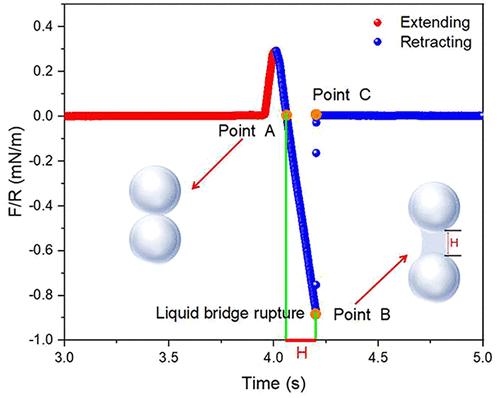Our official English website, www.x-mol.net, welcomes your
feedback! (Note: you will need to create a separate account there.)
Investigation on the Adhesion Force between Tetrabutylammonium Bromide Hydrate Particles Using Atomic Force Microscopy
Langmuir ( IF 3.7 ) Pub Date : 2024-09-24 , DOI: 10.1021/acs.langmuir.4c00953 Fan Xiao, Wei Wang, Longxin Chen, Kai Li, Yuntong Ge, Jionghao Li
Langmuir ( IF 3.7 ) Pub Date : 2024-09-24 , DOI: 10.1021/acs.langmuir.4c00953 Fan Xiao, Wei Wang, Longxin Chen, Kai Li, Yuntong Ge, Jionghao Li

|
This work investigates the adhesion force between tetrabutylammonium bromide (TBAB) hydrate particles dispersed in decane at different temperatures and TBAB concentrations using an atomic force microscopy. The thickness of the quasi-liquid layer (QLL) on the surface of the hydrate particles is calculated based on an adhesion force model. The results of force measurements indicate that the adhesion force between the hydrate particles increases with increasing temperature when TBAB concentration is 30 wt %. The increment of adhesion force between particles could be due to the increase in the QLL thickness on the particle surfaces. Furthermore, the force results also reveal that the adhesion force between hydrate particles(ice) at 253 K decreases when TBAB concentration increases from 0 to 30 wt %. The calculation indicates that QLL on the surface of formed hydrate particles becomes thinner at higher TBAB concentrations, which could be due to the conversion rate of water to hydrate within particles. The thickness of QLL is directly influenced by the temperature and TBAB concentration, which contributes to the adhesion force between hydrate particles.
中文翻译:

用原子力显微镜研究四丁基溴化铵水合物颗粒之间的粘附力
这项工作使用原子力显微镜研究了在不同温度和 TBAB 浓度下分散在癸烷中的四丁基溴化铵 (TBAB) 水合物颗粒之间的粘附力。基于粘附力模型计算水合物颗粒表面的准液体层(QLL)的厚度。力测量结果表明,当TBAB浓度为30 wt%时,水合物颗粒之间的粘附力随着温度的升高而增大。颗粒之间粘附力的增加可能是由于颗粒表面 QLL 厚度的增加。此外,力的结果还表明,当 TBAB 浓度从 0 wt% 增加到 30 wt% 时,253 K 时水合物颗粒(冰)之间的粘附力降低。计算表明,在较高的 TBAB 浓度下,形成的水合物颗粒表面的 QLL 变得更薄,这可能是由于颗粒内水向水合物的转化率所致。 QLL 的厚度直接受温度和 TBAB 浓度的影响,这有助于水合物颗粒之间的粘附力。
更新日期:2024-09-25
中文翻译:

用原子力显微镜研究四丁基溴化铵水合物颗粒之间的粘附力
这项工作使用原子力显微镜研究了在不同温度和 TBAB 浓度下分散在癸烷中的四丁基溴化铵 (TBAB) 水合物颗粒之间的粘附力。基于粘附力模型计算水合物颗粒表面的准液体层(QLL)的厚度。力测量结果表明,当TBAB浓度为30 wt%时,水合物颗粒之间的粘附力随着温度的升高而增大。颗粒之间粘附力的增加可能是由于颗粒表面 QLL 厚度的增加。此外,力的结果还表明,当 TBAB 浓度从 0 wt% 增加到 30 wt% 时,253 K 时水合物颗粒(冰)之间的粘附力降低。计算表明,在较高的 TBAB 浓度下,形成的水合物颗粒表面的 QLL 变得更薄,这可能是由于颗粒内水向水合物的转化率所致。 QLL 的厚度直接受温度和 TBAB 浓度的影响,这有助于水合物颗粒之间的粘附力。











































 京公网安备 11010802027423号
京公网安备 11010802027423号